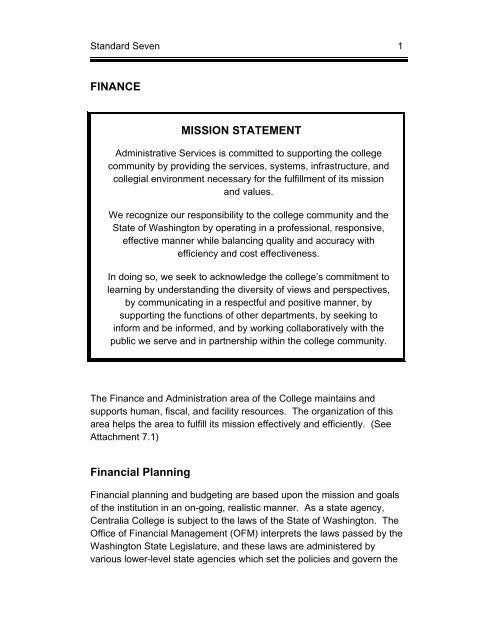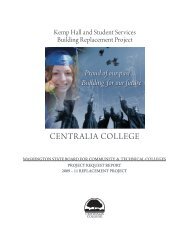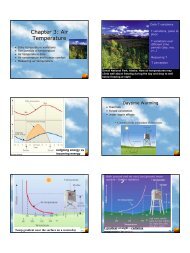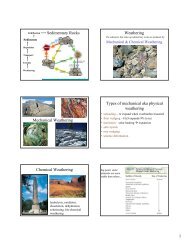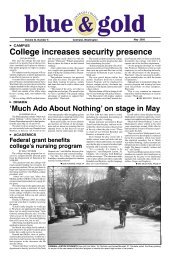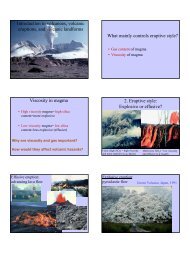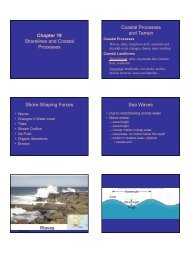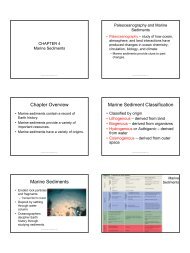FINANCE MISSION STATEMENT Financial ... - Centralia College
FINANCE MISSION STATEMENT Financial ... - Centralia College
FINANCE MISSION STATEMENT Financial ... - Centralia College
- No tags were found...
You also want an ePaper? Increase the reach of your titles
YUMPU automatically turns print PDFs into web optimized ePapers that Google loves.
Standard Seven 1<strong>FINANCE</strong><strong>MISSION</strong> <strong>STATEMENT</strong>Administrative Services is committed to supporting the collegecommunity by providing the services, systems, infrastructure, andcollegial environment necessary for the fulfillment of its missionand values.We recognize our responsibility to the college community and theState of Washington by operating in a professional, responsive,effective manner while balancing quality and accuracy withefficiency and cost effectiveness.In doing so, we seek to acknowledge the college’s commitment tolearning by understanding the diversity of views and perspectives,by communicating in a respectful and positive manner, bysupporting the functions of other departments, by seeking toinform and be informed, and by working collaboratively with thepublic we serve and in partnership within the college community.The Finance and Administration area of the <strong>College</strong> maintains andsupports human, fiscal, and facility resources. The organization of thisarea helps the area to fulfill its mission effectively and efficiently. (SeeAttachment 7.1)<strong>Financial</strong> Planning<strong>Financial</strong> planning and budgeting are based upon the mission and goalsof the institution in an on-going, realistic manner. As a state agency,<strong>Centralia</strong> <strong>College</strong> is subject to the laws of the State of Washington. TheOffice of <strong>Financial</strong> Management (OFM) interprets the laws passed by theWashington State Legislature, and these laws are administered byvarious lower-level state agencies which set the policies and govern the
Standard Seven 2operational procedures for state agencies. The OFM Manual has beenrenamed SAAM, the State Administrative and Accounting Manual.(Available in Exhibit Room)These policies and procedures are used in the day-to-day operations ofstate agencies and incorporated into the decision-making processes forfinancial planning and budgeting. The state's agencies follow accountingpolicies and procedures prescribed by the Governmental AccountingStandards Board (GASB) as interpreted by OFM.The State Board for Community and Technical <strong>College</strong>s (SBCTC)receives the statewide appropriations approved by the legislature andallocates them annually to all the state community and technical collegeson a formula basis. Allocations include general purpose funds as well asdedicated funds for specific purposes and initiatives. Additionalallocations may be received throughout the fiscal year. (See Attachment7.2)The <strong>Centralia</strong> <strong>College</strong> Board of Trustees reviews and adopts the college'sannual budget. Thereafter, the president and the designated budgetmanagers have the autonomy to manage their individual budget plansaccording to board policy.<strong>Centralia</strong> <strong>College</strong> has a strategic planning policy in place, but because ofthe funding methods used by the state legislature, only limited long-rangefinancial planning is possible. The legislature appropriates funding forstate agencies on a biennial basis. The SBCTC allocations are made forthe current year, based on a dollar value for each full-time equivalentstudent (FTE); thus, financial planning is basically limited to a two-yearcycle.The strategic planning objectives for 1999-2000 are:1. Total State Enrollment TargetsThe strategic long-term enrollment target for <strong>Centralia</strong> <strong>College</strong> should beto increase excess enrollment by 2% per year until 112% of the stateallocated FTEs has been reached and maintained.
Standard Seven 32. Off-site, Evening, and Day EnrollmentThe target for Tenino/Morton is an increase of 100 FTEs at each site by2004/05 with evening classes on all campuses making up 20% of the totalFTEs by 2004/05 (equal to the system average).3. Instructional Mix EnrollmentsThe targets have also been set for specific programs:Developmental Education 7%Basic Skills 16%Professional Technical 32%Academic Transfer 45%(See Strategic Planning Documents available in Exhibit Room)Two major areas that do permit longer-range planning are facultysalaries/benefits and equipment acquisitions. The negotiated agreementfor faculty has a three-year term, so planning for salaries, staffdevelopment funds, and similar costs is possible. When the legislatureappropriates funding for salary increases for faculty increments, annualnegotiations are held to determine the distribution of those funds.Capital planning is completed statewide for all community and technicalcolleges using a six-year cycle. New facilities go through a threebienniumprocess that includes appropriations for planning during the firstbiennium, architectural drawing during the second, and constructionduring the third. <strong>Centralia</strong> <strong>College</strong> is currently in the process ofconstructing a new instructional facility which is slated for completion inSpring 2001. This structure will have a new theatre as well asclassrooms and offices to support the areas of art, music, theatre, radiotelevision,and business. Because of dangerous conditions of the existingfacility (Corbet Hall), this process of capital planning was expedited. (SeeStandard 8 for further discussion)State allocations come from the general fund and are, therefore, tied tothe economic climate of the state. Forecasts of the state's overalleconomic climate form the basis of legislative strategic long-rangeplanning. The legislature uses that information to determine tuition rates
Standard Seven 4for the community and technical college system. A portion of studenttuition is retained as local operating funds and used in <strong>Centralia</strong> <strong>College</strong>'soperating budget.The <strong>College</strong> accomplishes short-range planning for instruction,administrative services, and student services through an annual reviewand planning cycle. Each academic department is supplied with itsenrollment and financial history and given the opportunity to forecastfuture enrollment, personnel, and program needs. This is also theopportunity to plan for changes in existing programs and implementationof new programs. For the past few years, the state has also appropriatedmoney for Workforce Training that requires the <strong>College</strong> to plan andimplement programs that will meet the immediate training needs ofspecific members of the state's workforce. Examples include theCorrectional Officer Program, New Chance, Life after Layoff Workshops,and financial aid special advising.<strong>Centralia</strong> <strong>College</strong> also adds other local funding sources to the stateallocation in order to support an operating budget plan. These include,but are not restricted to the following:• Excess Enrollment—The SBCTC allocationassumes an operating fee income level based onhistorical FTE trends. If actual enrollment exceedsthat level, the college may retain the excess fundsgenerated for the operating budget.• International Enrollments—This funding comesfrom the enrolling of international students who paynon-resident tuition. The FTE’s generated by thesestudents are not counted or reported as part of thecollege's state-funded enrollment target.• Running Start—Local high school students mayattend <strong>Centralia</strong> <strong>College</strong> after meeting certainadmission requirements. The Washington StateLegislature established the Running Start programin 1989, allowing high school students to takeclasses at the state's two-and four-year collegesand universities. FTE’s generated by thesestudents are not counted or reported as part of the
Standard Seven 5college's state funded enrollment target. The homeschool districts of these students classes report theFTE’s and pay the <strong>College</strong> for each studentenrolled in college courses through the RunningStart program.• Indirect/Administrative Allowance—This fundingcomes from indirect/administrative costs includedin some grants and contracts. This fund is used tocover administrative overhead costs andemployment costs incurred from expired grants andcontracts. These additional funding sources arecritical to <strong>Centralia</strong> <strong>College</strong>'s financial planningprocess since they are used to balance the overalloperating budget.Annual Budget<strong>Centralia</strong> <strong>College</strong>'s Budget Review and Planning Committee (BRP) sendsout carry forward budgets and parameters to budget managers accordingto the budget calendar. (See Attachment 7.3) Budget managers usethese documents along with input from division staff to plan and supportbudget decisions. The budgeting development process then followsregularly scheduled planning and budgeting activities which promotemaximum participation by all college constituencies. The budget processnormally occurs during the months of February through May.The first step in the process is the creation of an initial budget by theBudget Office. This first draft usually includes updated salary and benefitprojections for the current level of staffing. It may also list other pertinentinformation according to the BRP budget process calendar. Thesematerials are distributed to all budget managers, the individuals ordesignees appointed by the <strong>College</strong> president or appropriateadministrator responsible for managing specific areas of the budget.Budget managers are the vice presidents and administrator in the threeareas of the <strong>College</strong>.
Standard Seven 6Each program of the college develops its own budget request using theinformation from the Budget Office, historical staffing ratios, enrollmenttargets, and its program review recommendations. Through a continualprocess of additions/deletions and updated summarizations presented tothe administration, the budget is preliminarily balanced against theprojected state allocation, estimated tuition revenue, and other localrevenue used to supplement the operating budget. These summaries arepublished and copies are distributed to BRP members, the TeachingLearning Center (TLC), the Library, and each vice president's office. Thevice-presidents then present the drafted budget to the BRP at an openhearing that provides all college constituency groups an opportunity toreview the status of the budget, ask questions, and provide input.That preliminary budget is then recommended to the <strong>College</strong> Council andpresented in-depth to the Board of Trustees at an annual workshop. Thispresentation provides board members an opportunity to understand thedetails of the budget and the process by which it was developed. Duringthis process, BRP members share any concerns about the upcomingbudget year.The Board then formally approves and adopts the budget at its regularlyscheduled meeting. Detailed copies are distributed to the president andeach vice president, and hard copies are placed in the college library,Teaching and Learning Center, and the vice presidents' offices foremployees, students, and members of the public to review. When theactual state allocation is approved by the legislature and distributed bythe SBCTC, the President's Cabinet makes its final balancingadjustments to the budget. Administration, Board of Trustees, and BRPmembers receive copies of the final budget.Following Board adoption, the budget managers have the autonomy toapprove expenditures within prescribed budgetary constraints. Budgetauthorities are provided with a printed monthly summary and detailedreports which reflect the budget's current activity and year-to-datebalances. Business Office staff and department support staff reviewthese reports and make necessary adjustments. Any budget revisionsare submitted by the budget managers and approved by theadministration as needed. These changes are reflected in their monthlyreports. <strong>Centralia</strong> <strong>College</strong> follows the OFM guidelines for internal control
Standard Seven 7and the safeguarding of assets by conducting an annual assessment toidentify areas of concern or potential risk. This risk assessment is auditedannually by the State Auditor's Office.The Business Office and budget managers monitor transactions to assurethat only designated managers commit funds for expenditures and allproposed expenditures comply with any special rules or regulationsattached to a specific budget. In addition, the <strong>College</strong> maintains internalcontrol procedures that require the Business Office staff to pre-audit allpurchase requisitions for proper budget coding, signature authority, andappropriateness of the expenditure. It also requires the Budget andPayroll Office staff to pre-audit the payroll documents and all budgetauthorities to review monthly budget printouts for the accuracy ofexpenditures charged to their accounts.Budgets for specific grants or contracts, for example, may haverestrictions on the types of expenditures that can be made with the funds.In addition, Business Office and other support staff complete all thenecessary reports and specific information requests from governingagencies.On the other hand, adequacy of the equipment budget has historicallybeen problematic. In order to work with this problem, the equipmentrequests are listed and prioritized so the involved staff can agree whatequipment will be funded first. Resources only permit funding of thehighest priorities.Capital OutlayAs a state agency, <strong>Centralia</strong> <strong>College</strong> has no substantial debt for capitaloutlay. The majority of the buildings on campus were funded by statecapital appropriations backed by state issued bonds. A portion of studenttuition is designated for the bond redemption, with remittance to the StateTreasurer's Office occurring within 35 days of the start of a quarter. TheBoard of Trustees, in turn, must approve local funding for buildings orimprovements and notification must be sent to the State Board for
Standard Seven 8Community and Technical <strong>College</strong> (SBCTC) staff. If the amount is$200,000 or greater, the State Board must grant formal approval.<strong>Financial</strong> Resources<strong>Centralia</strong> <strong>College</strong> uses many different sources of funds. The stateallocation is based on a dollar amount per full-time student (1998-99FTE = $4,235), allocated to the college by the SBCTC. Tuition and feerevenues are also part of the overall operating budget. These funds arerecorded by student status and type of revenue which is defined at thestate level. As discussed, the State Budget and SBCTC determine theadequacy and stability of the allocation.In 1999, the SBCTC recognized the difficulty some colleges wereexperiencing in enrollment patterns, so they instituted an "FTEmoratorium" to allow schools with enrollments lower than their target FTElevel an additional two years to reach designated enrollment levels beforetheir base allocation would be cut.In addition to the state allocation, <strong>Centralia</strong> <strong>College</strong> funds its programsand services with monies from a variety of grants and contracts which thecollege aggressively sought and secured. Specialized occupational,technical, and professional programs have access to additional resourcessuch as federal Carl Perkins funds, Workforce Training allocations, TechPrep funds, and field-specific grants and contracts. Outside accreditingbodies and professional technical advisory boards assess and makerecommendations regarding the adequacy of funding and equipment forthese programs. There are currently over 50 grants and contracts whichadd over 4.5 million dollars to the base state allocation. (See Attachment7.4)All of these requests for additional funding are reviewed by the director ofinstitutional research and external funding and the External FundingCommittee to ensure that they reflect the mission, goals, and priorities of<strong>Centralia</strong> <strong>College</strong>.
Standard Seven 9Most grants and contracts specifically stipulate use of resources; whereasfunds generated by Running Start and international student contracts areallocated among several college programs. The specific use of funds isincluded in the annual operating budget which goes through a reviewprocess by the campus community, the Budget Review and PlanningCommittee, the <strong>College</strong> Council, and the President’s Cabinet. Finalreview and approval is done by the <strong>Centralia</strong> <strong>College</strong> Board of Trustees.<strong>Centralia</strong> <strong>College</strong> also uses 10% of the net International Programrevenues and excess enrollment funds for the Lovington Awards. Thesefunds are named for a deceased faculty member who served as the firstBRP chair. This unique and popular program funds proposals which haveno other (or inadequate) funding sources and which are tied to thecollege's Strategic Planning Priorities. In 1998, the Lovington Awardsfunded almost $63,000 in college-wide projects such as health and fitnessequipment, technology classroom improvements, and an electronic musiclab. The detailed allocation of these funds is summarized in eachcontract's yearly budget. (See Attachment 7.5, 7.6, 7.7, 7.8)At <strong>Centralia</strong> <strong>College</strong>, auxiliary enterprises are food service, bookstore,and daycare. <strong>Centralia</strong> <strong>College</strong> does not use auxiliary enterprise incometo balance the operating budget. While state funds are not directly usedto balance the auxiliary budget, state-funded administrative supportservices are provided. In the case of the daycare, which also serves asan instructional child study lab, state-funded positions are provided.Another funding source, the <strong>Centralia</strong> <strong>College</strong> Foundation, supportscollege programs through the coordination and administration offundraising activities. These funds include money designated for specificprograms i.e., nursing, committees i.e., the Wellness Committee andFriends of the Library, college facilities i.e. <strong>Centralia</strong> <strong>College</strong> East, andstudent scholarships.
Standard Seven 10<strong>College</strong> DebtAs a state agency, <strong>Centralia</strong> <strong>College</strong> is not allowed to have indebtedness,and its financial statements (IPED reports) show a history of financialstability. No deficit is accumulated.Audits<strong>Centralia</strong> <strong>College</strong> has a history of clean audit reports. Interfund transfersare legal in this state and guided by state policies and regulations.Money transfers are recorded using generally accepted accountingprinciples set forth by the Office of <strong>Financial</strong> Management. The <strong>Centralia</strong><strong>College</strong> Business Office staff routinely processes transfers.<strong>Financial</strong> AidThe <strong>Financial</strong> Aid Office identifies and monitors the sources and studentseligible for financial aid. These sources include federal, state, and<strong>Centralia</strong> <strong>College</strong> Foundation scholarships.As allowed by state law, 3½% of tuition is used for <strong>Centralia</strong> <strong>College</strong> grantawards to meet unmet, unfunded financial needs. The <strong>Financial</strong> AidOffice also uses a Needy Tuition Waiver to meet unfunded financial aidneeds.Contingency Fund<strong>Centralia</strong> <strong>College</strong> has a history of maintaining a contingency fund ofapproximately 2% (ideally 2%; in actuality 1.6-1.8%) of the operatingbudget. This fund is available for fluctuations in revenues and expenses.Historically, these funds have been distributed to the different areas of thecollege at the end of the fiscal year (state policy discourages actual carryoversavings accounts). However, in 1997, when the Title III grant ended,
Standard Seven 12<strong>Centralia</strong> <strong>College</strong> controls all its revenue and expenditures through theuse of a common statewide financial software system, in conjunction withits internal control procedures. This financial software system definesrevenue sources, objects of expenditure, general ledger charts ofaccount, and common input and reporting formats.The basic accounting structure for all state agencies is supported by theCenter for Information Services (CIS) formed in 1975 and set by theOffice of <strong>Financial</strong> Management (OFM). Its policies are in the StateAdministrative and Accounting Manual and also via OFM web page. Thiscommon financial system provides for the recording of all financialactivities in accordance with generally accepted accounting principles. Itincludes:• Budget Development and Tracking• Accounting (Chart of Accounts, Cashiering,Accounts Receivable, and Accounts Payable)• Payroll and Personnel• Student Registration and Records• <strong>Financial</strong> Aid• Facilities and Equipment InventoryThe recording of these financial activities meets the accounting andauditing requirements of the OFM, State Auditors Office (SAO), StateBoard for Community and Technical <strong>College</strong>s (SBCTC) and other federal,state, and local agencies. In addition, each individual college determinesits own departmental code structures that reflect its individualadministrative organization.Cash ManagementThe <strong>College</strong> has clearly defined and implemented policies regarding cashmanagement and investments which have been approved by thegoverning board. It has a written cash management/investmentprocedure supported by the President's Cabinet, detailing the cash flowmanagement and investment policies of the campus. The WashingtonState Auditor's Office regularly audits the <strong>College</strong>'s investmenttransactions and procedures. All funds are included in these audits. The
Standard Seven 13<strong>College</strong> submits an updated electronic cash management activity reportto the Office of <strong>Financial</strong> Management as required through the Agency<strong>Financial</strong> Reporting System (AFRS) and the State Asset ReportingSystem (SARS).<strong>Centralia</strong> <strong>College</strong> responds promptly to any concerns addressed in themanagement letter accompanying its annual audit report, and the StateAuditor's Office (SAO) reviews prior concerns for compliance duringsubsequent audits. In addition, the State Board for Community andTechnical <strong>College</strong>s (SBCTC) annually reviews specific collegeprograms/functions and checks for consistency of reporting amongcommunity and technical colleges.Special audits of governmental programs do occur, although the SingleAudit Act delegates responsibility for audit of federal funds to the StateAuditor's Office. They are public records available as described in WAC132Y-320.Fundraising and DevelopmentFundraising activities are orchestrated by the <strong>Centralia</strong> <strong>College</strong>Foundation. The Foundation was established in 1982, and since 1986,the Foundation has held Annual Fund Campaigns as its basic fundraisingprogram. The <strong>Centralia</strong> <strong>College</strong> Foundation administers endowment andlife income funds and their investments. Complete records aremaintained by the Foundation staff ( Executive Director, Secretary).Audits confirm that these records are accurate, complete, and complywith applicable legal requirements.Annual audits conducted by an independent certified public accountantfirm have confirmed the Foundation's activities as ethical, professional,and in compliance with state and federal guidelines for non-profitorganizations. Currently, the Foundation manages an endowment andscholarships in excess of $5 million. The Capital Campaign, “Reach ForThe Stars” is an additional effort by the Foundation to raise over $1M forthe new instructional building.
Standard Seven 14Since fundraising is done by the Foundation, there are currently nospecific <strong>Centralia</strong> <strong>College</strong> institutional policies regulating fundraising.Policies and procedures are determined by the Foundation Board ofDirectors which consists of 24 community members who also ensure thatall activities are carried out in a professional and ethical manner.<strong>Centralia</strong> <strong>College</strong> and the <strong>Centralia</strong> <strong>College</strong> Foundation have a clearlydefined relationship. This is represented by the agreement between<strong>Centralia</strong> <strong>College</strong> and the <strong>Centralia</strong> <strong>College</strong> Foundation aka Quid ProQuo Agreement. (Available in Exhibit Room)Student clubs and organizations sometimes hold fundraising activitiesand events. These must be approved by (and are closely monitored by)the Director of Student Programs who oversees the budgets of studentclubs and organizations. They are governed by the Fundraising Policyfound in the <strong>Centralia</strong> <strong>College</strong> Club and Organization Handbook.Analysis<strong>Centralia</strong> <strong>College</strong> has had its ups and downs with state funding based onFTE’s. Enrollment has declined for the past few years, but with newlydeveloped strategic planning goals, the MART Committee, and an all-outeffort to recruit and retain students, the college has raised its enrollmentconsiderably. It is the oldest continuously operating community college inWashington state which is in itself a testimony to its survival skills andresiliency. <strong>Centralia</strong> <strong>College</strong> knows state funding tends to be fickle andusually below what is necessary to meet all the demands of itsconstituencies. Following an enrollment downturn, the <strong>College</strong> gatheredits resources, planned for the most efficient way to meet essentialactivities and goals, began a campus-wide movement to promote itself,and put into place evaluation tools to assess its effectiveness. The<strong>College</strong> has adopted the three-step loop of planning, implementing, andassessing. This loop is currently in a three-year cycle of strategicplanning, and although parts of it are on-going, a new cycle will begin in2001.
Standard Seven 15The state funding uncertainty makes it difficult to know what monies willbe available in the <strong>College</strong> budget for the maintenance and replacementof equipment. This is due to the fluctuations in legislative funding and thevarying needs of staff, faculty, and students. To address this concern, the<strong>College</strong> needs to develop a long-term plan for the acquisition andreplacement of equipment related to instruction. Staff and faculty willneed to prioritize and estimate the life of the most essential equipmentneeds in order to give budget managers a better idea of futureexpenditures.<strong>College</strong> growth and accountability have increased the workload for manystaff. This concern is evident in the staffing levels of the finance andoperations areas which have not kept pace with the overall growth andcomplexity of programs, grants/contracts, technology, and other activitiesof the college. This deficiency limits the finance and operation staff'sability to respond consistently and in a timely manner to requests fromcollege employees, vendors, state and federal agencies, and communitymembers.Standard Seven Future Directions• Identify and prioritize long-range funding needs• Evaluate the effectiveness of the current strategicplanning priorities• Meet the goal of the Foundation capital campaign• Allocate funding for furniture and equipment toeffectively and efficiently fulfill the purpose of thenew instructional building


